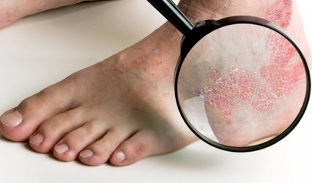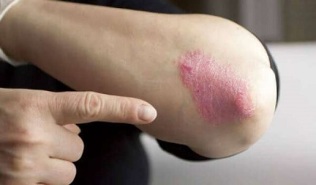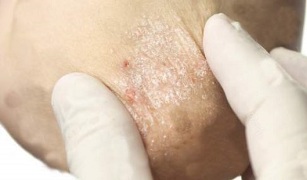Psoriasis is an inflammatory disease of the skin. Occurs when the immune system is malfunctioning. The development of the disease is divided into clear stages - the onset, progression, stabilization and regression. The different stages of psoriasis differ in the appearance of spots and rashes, itchy pain and extensive skin inflammation.
Why is it necessary to distinguish between the stages of development of the disease and what are the characteristics of the course of psoriasis in the early stages of development and during recovery?
Why you need to know the stages of psoriasis

The division of psoriasis into stages is used by doctors for the correct choice of therapeutic methods. A complex of drugs and external agents prescribed to treat inflammation depends on the stage of development of the disease.
At the onset of the manifestation of the disease, general treatment is required - vitamin complexes, diet, external aseptic treatment of the rash, for example, a series of UV procedures. Also prescribed drugs that stimulate the cleansing of the intestines, blood vessels, liver.
Be sure to perform the correction of psycho-emotional state - by a neurologist or psychologist.
At the initial stage of the disease, they do not use strong drugs that turn off the immune system, do not prescribe hormonal ointments. These drugs have a long list of side effects, so they are prescribed only when it is impossible to do without them.
Psoriasis: treatment in acute stage and in remission
In the case of an acute progressive course of the disease, several drugs of various actions are prescribed. Immunosuppressants and glucocorticosteroids are often used to relieve inflammation and reduce itching. External treatments are supplemented by photochemical, ultrasound and laser therapy. In addition, agents are prescribed for the antiseptic treatment of damaged skin.
In a stabilized state, they continue to take hormonal anti-inflammatory drugs, gradually reducing their dose. To restore damaged skin, ointments with a regenerating effect are prescribed.
In remission - support the body. Correct nutrition, take vitamin and mineral complexes to restore immunity.
Punctuality of treatment
The earlier treatment is started, the easier it is to control psoriasis.

Timely therapy restricts the spread of skin inflammation, reduces its extent, prevents subsequent relapses of desquamation. Since psoriasis is often mistaken for an allergic rash at an early stage, it is necessary to know its first signs so as not to miss the onset of a skin disease.
Note:Doctors are always investigating the causes of psoriasis. But it is well known that psoriatic inflammation of the skin is not contagious. It cannot be taken from a sick person, nor from an infection in the event of an injury. It is our own personal failure in the human body.
The cause of psoriasis is immune failure, which can be caused by various factors. Severe stress, intoxication (including strong drugs, industrial waste, alcohol), previous infection.
Psoriasis is difficult to treat. The disease is prone to relapses, relapses. And the therapy itself is symptomatic. It consists of preventing the appearance of new spots and relieving existing itchy skin.
What stage of psoriasis is called initial? How to distinguish early psoriasis from diathetic rash? And how will the disease develop in the future?
Psoriasis: initial stage
The first appearance of psoriasis on the skin looks like pimples. Most often, the rash appears in the folds of the elbows and knees, or in places where clothes are tightly pressed against the body (for example, below the belt at the waist). Rashes can also appear along the edge of the hair and under the hair, around the nails and on the nail plates. Sometimes psoriasis occurs on the feet and palms.
Almost always, psoriasis manifests itself symmetrically - on the elbows of both hands, or on both sides of the lower back, or on two knees.
The pimples themselves (in medical terminology - papules) at the initial stage have a modest appearance. They have:
- Pink or red;
- Sharp and fuzzy edge;
- Small size - the button at the base does not exceed two millimeters;
- Flat shape - the small punctuated pimples at the onset of the disease have almost no bulges, so they look like spots.
As the disease progresses, flakes of peeling skin appear on the pimples. They are gray or silvery, on the background of a red button they appear white.
The appearance of scales is accompanied by quite severe itching. If you don't resist and scratch, the scales are removed, exposing the shiny areas of young, pink skin below. He is very thin, vulnerable, with prolonged scratching of itchy papules - he is injured, bleeds.
The initial phase of psoriasis lasts up to four weeks.
Psoriasis: stage of progression

In the progressive stage, the individual pimples merge into a single common point, forming the so-called psoriatic plaques. They are raised above the surface of the skin and are almost completely covered with coat. On the edges of psoriatic plaques there is an unscaled pink-red border.
The presence of a rim is indicative of a progressive stage of the disease. The rim is one to two millimeters wide. The skin on it is inflamed and looks like parchment paper in structure.
The edge represents the expansion area of the spot. It is the skin that is already inflamed, but not yet peeling. After a while, it will also be covered with scales. And the patch will expand to cover new areas of the skin and form a new wider edge.
With the active development of the disease, adjacent spots merge with each other. At some point, a large inflamed red spot can form on the human body.
Psoriatic plaques are very itchy, giving a person unpleasant sensations, interfering with work, rest and sleep. They grow, occupy a large area, and form a new rash on clean, healthy skin.
The main sign of the progressive stage is the appearance of new rashes. As soon as new pimples and spots stop appearing, the next stage of psoriasis begins - stationary. It is not yet a complete victory, but it is already a turn towards recovery.
In the progression stage, psoriasis is almost always accompanied by weakness, fatigue, weakness. Depression is common. Temperature possible.
Note:some medical theories say otherwise. Depression is not a consequence of psoriasis. And psoriasis is a consequence of neurology, of the depressive psyche.
The duration of the progressive stage of psoriasis can be long, several months.
Psoriasis: stationary stage

The main sign of the stationary phase is the cessation of the appearance of new spots and rashes. At the same time, the itching also decreases, it becomes more bearable. The rash loses its bright color, becomes discolored, becomes invisible. It is also one of the signs that the process is stabilizing.
The pink edges around the plaques disappear when the inflammation stops spreading. Beginning of active exfoliation and healing, regeneration of new healthy skin.
We notice with the naked eye that the coat increases at the stationary stage. The scales completely cover the entire surface of the psoriatic spot, leaving no space for the rims.
Psoriasis takes on the characteristic scaly appearance that is commonly recognized by the general public. Extensive coat at the stationary stage is not dangerous.
When all the dead cells come out of the surface of the psoriatic spot, healthy skin with a slight light tint will remain in their place.
Other signs of progression or stabilization
In addition to the appearance of the rash, spots and peeling, there are a number of other signs that can be used to judge the development of the disease. It is the nature of the itching sensations (strong or tolerable), the general condition, the depressed mood. And also the presence of temperature.
At the initial stage, the itching is variable and the rash is incomprehensible. In addition, the itching intensifies every day. At the acute stage of psoriasis, it becomes intolerable. Disrupts sleep, rest, interferes with work. The person becomes irritable because the itching sensations do not give him the opportunity to rest.
At the stationary stage, the itching goes away. Every day a person feels better. The general state of the psyche changes, negativity and depressive moods weaken. The duration of the stationary stage is several weeks - from 2 to 5.
Alleviating psoriasis

The discoloration stage of psoriasis is the almost complete disappearance of plaques, spots, redness, inflammation, itching.
At this stage of the disease, psoriasis only recalls different skin pigments. On the site of the old psoriatic spots, it appears lighter. The surface of healthy skin has a darker shade.
In some cases, the so-called hyperpigmentation is formed. The skin at the site of the psoriasis spots does not become lighter, but darker. In any case, the differences in skin pigmentation will be visible for another one to two months.
Psoriasis after recovery: possibility of relapse
The possibility of psoriasis relapse is determined by lifestyle, diet, allergic mood and the condition of the body as a whole. It is also determined by the amount of toxins in his body, blood, liver. You can reduce the risk of repeated skin inflammation if you strengthen the immune system and cleanse the body of toxins in the liver, blood vessels, and intestines.
Seasonal relapses of psoriasis are often rare after cleansing. A person remains susceptible to the disease, but the likelihood of its occurrence is significantly reduced.
Cleansing the body of toxins and taking vitamin and mineral complexes helps to strengthen immunity. This is especially important if immunosuppressants have been used during treatment in the progressive stage of psoriasis. Their need was due to the work of inflammatory mediators. After suppressing the autoimmune defense, it is necessary to restore the immune system.























